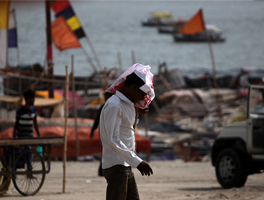 |
Dear readers,
Welcome to the Climate Weekly newsletter by the Centre for Science and Environment’s Climate Change programme and Down to Earth.
In the recently released Climate Risk Index (CRI), published by the non-profit Germanwatch, India ranks sixth among the countries most affected by extreme weather events over the last three decades from 1993-2022. According to the report, more than 400 extreme events—including cyclones, floods and heatwaves—have impacted the country over that period, causing $180 billion in losses and at least 80,000 fatalities. Globally, extreme weather events have caused more than 765,000 fatalities and economic losses exceeding $4.2 trillion.
Among the ten most impacted countries between 1993 and 2022, India, Pakistan and the Philippines were primarily affected by recurring extreme events, while Dominica, Honduras, Myanmar and Vanuatu were primarily affected by exceptional extreme events. Moreover, five of these countries, including India, were from the lower middle-income group, two (Dominica and China) belonged to the upper middle-income category, while three (Italy, Greece and Spain) were from the high-income group.
Furthermore, CSE and Down to Earth’s analysis of extreme weather events in 2024 shows that India faced extreme weather on 322 out of 366 days, or 88 per cent of the year. This figure is an increase from 87 per cent in 2023 and 86 per cent in 2022. The events that were recorded include heat and cold waves, cyclones, lightning, heavy rain, floods and landslides. The number of fatalities also saw an increase from 2022, rising by 15 per cent from 3,026 to 3,472 in 2024. The analysis further sheds light the severe impact of extreme weather events on agriculture, with at least 4.07 million hectares of cropped land being impacted—an 84 per cent increase from 2.21 million hectares in 2023.
Lastly, while we are starting to witness a pushback against climate action in the age of Donald Trump, it is crucial to reaffirm the pursuit of decarbonisation pathways for the Global South. CSE’s Director-General Sunita Narain writes about the necessity of pursuing inclusive development, sustainability and the clean energy transition to improve livelihoods and economies while reducing climate risks. Speaking about India’s clean energy transition, Narain points towards the necessity for low-carbon growth strategies, increasing the installed capacity for renewable sources, and moving towards round-the-clock projects (for example, by utilising battery storage) to compensate for the intermittency of renewable sources. This, she states, is critical for India to achieve its 500 GW clean energy target.
|
|
 |
| |
 |
|
| |
 |
 |
| |
By - Upamanyu Das
Climate Change, CSE
|
| |
|
 |
|
|
| |
 |
|
| |
| EXTREME WEATHER TRACKER |
| |
In 2024, India experienced extreme weather events on 322 days, surpassing records of previous years, 13 February 2025
|
 |
 |
|
|
| |
 |
|
| |
 |
 |
India among top 10 countries most affected by extreme weather events, economic losses amount to $180 billion over last three decades: Report, 13 February 2025
|
|
|
| |
|
|
| |
|
|
| |
 |
|
| |
|
|
| |
 |
|
| |
|
|
| |
|
|
| |
|
|
| |
 |
|
| |
CLIMATE NEWS | SCIENCE| IMPACTS| POLITICS |
|
| |
 |
|
| |
|
|
| |
 |
|
| |
|
|
| |
 |
|
| |
|
|
| |
 |
|
| |
|
|
| |
 |
|
| |
|
|
| |
 |
|
| |
|
|
| |
 |
|
| |
|
|
| |
 |
|
| |
|
|
| |
 |
|
| |
 |
 |
|
IMD at 150, 8 February 2025
|
 |
|
India’s journey into modern weather forecasting took a decisive turn 150 years ago with the establishment of India Meteorological Department during the British rule. The agency has come a long way since then, shaping the way the country predicts and responds to its diverse climate challenges
|
|
 |
|
|
| |
 |
|
| |
|
|
| |
 |
|
| |
|
|
| |
 |
|
| |
|
|
| |
|
|
| |
|
Gobar Times |
|
Online Training Course |
| |
|
|
|
|
|
|
|
|
| |
|
|
|